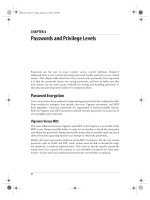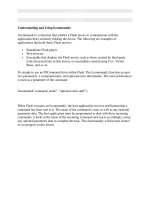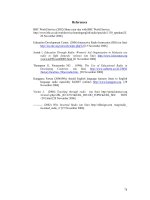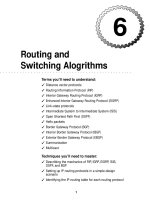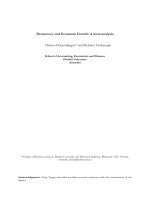Tài liệu Cohesion and Coherence self-study pdf
Bạn đang xem bản rút gọn của tài liệu. Xem và tải ngay bản đầy đủ của tài liệu tại đây (177.15 KB, 46 trang )
TU-CHEMNITZ
ENGLISH FOR ACADEMIC PURPOSES
COHERENCE & COHESION
Presenter: Raşide Dağ
What makes a text cohere?
What differentiates a cohesive grammatical
unit from a random collection of sentences?
Introduction:
Introduction:
Cohension and coherence are terms used in
discourse analysis and text linguistics to
describe the properties of written texts.
Advertising language tends not to use clear
markers of cohesion, but is interpreted as
being coherent.
Definitions:
Coherence:
The ways a text makes sense to readers & writer through
the relevance and accessibility of its configuration of
concepts, ideas and theories.
Cohesion:
The grammatical and lexical relationship between different
elements of a text which hold it together.
Coherence :
a semantic property of discourse formed through
the interpretation of each individual sentence
relative to the interpretation of other sentences,
with "interpretation" implying interaction between
the text, the reader and the writer.
a property that a reader will discern in the text
allows the reader to make sense of the text
refers to the semantic unity created between the
ideas, sentences, paragraphs and sections of a piece
of writing.
Coherence vs. Cohesion
Coherence:
very general principle of
interpretation of language
in context
fewer formal linguistic
features
e.g vocabulary choice
relationships deal with text
as a whole
based on primarily
semantic relationships
errors much more
obvious
Cohesion:
formal linguistic features
e.g repetition,reference
semantic relationships
between sentences and
within sentences
determined by lexically
and grammatically overt
intersentential
relationships
more recognizable
Is it coherent or not?
The ancient Egyptians were masters of preserving dead
people's bodies by making mummies of them. Mummies
several thousand years old have been discovered nearly
intact. The skin, hair, teeth, fingernails and toenails, and
facial features of the mummies were evident. It is possible
to diagnose the disease they suffered in life, such as
smallpox, arthritis, and nutritional deficiencies. The process
was remarkably effective. Sometimes apparent were the
fatal afflictions of the dead people: a middle-aged king died
from a blow on the head, and polio killed a child king.
Mummification consisted of removing the internal organs,
applying natural preservatives inside and out, and then
wrapping the body in layers of bandages.
Below is the same paragraph revised for coherence. Italics
indicates pronouns and repeated key words, bold indicates
transitional tag-words, and underlining indicates parallel
structures.
The ancient Egyptians were masters of preserving dead
people's bodies by making mummies of them. In short,
mummification consisted of removing the internal organs,
applying natural preservatives inside and out, and then
wrapping the body in layers of bandages. And the process
was remarkably effective. Indeed, mummies several
thousand years old have been discovered nearly intact. Their
skin, hair, teeth, fingernails and toenails, and facial features
are still evident. Their diseases in life, such as smallpox,
arthritis, and nutritional deficiencies, are still diagnosable.
Even their fatal afflictions are still apparent: a middle-aged
king died from a blow on the head; a child king died from
polio.
According to Halliday & Hasan,
A text is a semantic unit whose parts are linked together by
explicit cohesive ties.
Cohesive tie: a semantic and /or lexico-grammatic relation
between an element in text and some other element that is
crucial to interpretetion of it.
Eventhough within-sentence ties occur the cohesive ties across
‘sentence boundaries’are those which allow sequences of
sentences to be understood as text.
Cohesion therefore defines a text as text.
Reference
Ellipsis
Substitution
Conjunction
Lexical Cohesion
Halliday & Hasan identify general categories of
cohesive devices that signal coherence in texts:
Grammatical
Cohesion
Halliday & Hasan's Taxonomy of
Cohesive Devices :
Reference :
Replacement of words and expressions with pro-
forms.
e.g pronouns,pro-modifiers.
Three types of reference:
Personal
Demonstrative
Comparative
Personal (communication goal of referent)
Demonstrative (proximity of referent)
Comparative ( similarity to preceding referent)
REFERENCE
Cohesion consists in continuity of referential
meaning (relatedness of reference) ;
Types of reference:
Personal Reference
a reference by means of person,
includes;
Personal pronouns (e.g., I, he, she)
Possesive pronouns (e.g., mine, hers, his)
Possesive determiners (e.g., my, your, her)
e.g. English is considered an international language.
It is a spoken by more than 260 million people all
over the world.
They told me you had gone by her car
Demonstrative Reference
essentially a form of verbal pointing
the speaker identifies the referent by locating it
on a scale of proximity.
In general,
this, these and here imply proximity to the
speaker;
that, those and there imply distance from the
speaker.
Demonstrative Reference
Like personals, the demonstratives regularly refer
exophorically to something within the context of
situaiton.
e.g. How do you like a cruise in that yacht?
Pick these up!
Comparative Reference
contributes to textual cohesion by setting up a
relation of contrast
expressed by such adjactives as same, identical,
equal, adjectives in a comparative degree such as
bigger,faster and adverbs such as identically,
likewise, so, such etc.
e.g. She has a similarly furnished room to mine.
The little dog barked as noisily as the big one.
They asked me three equally difficult questions.
REFERENCE
(Situational)
{EXO}{PHORA}
(Textual)
{ ENDO}{PHORA}
{ANA}{PHORA} {CATA}{PHORA }
Halliday and Hasan call within text
cohesive ties endophoric, and references,
items outside the text exophoric :
OUT(SIDE)
IN(SIDE)
Halliday and Hasan call within text cohesive
ties endophoric,
e.g. Wash and core six cooking apples. Put them
into a fireproof dish.
an example of an endophoric reference when
them referred back to apples.
Reference signals to the reader what kind of
information is to be retrieved.
Them, therefore, signals to the reader that he or she
needs to look back in the text to find its meaning.


